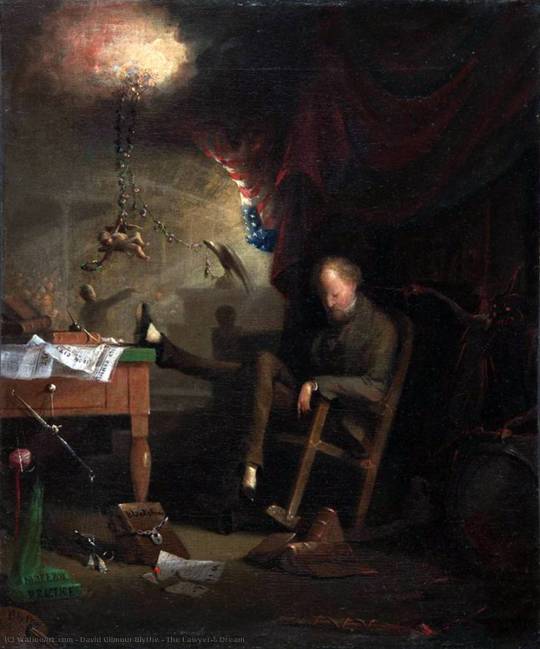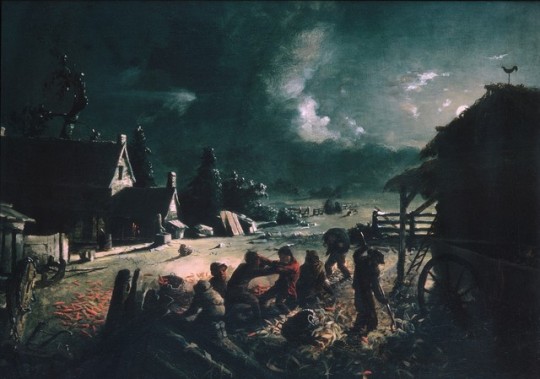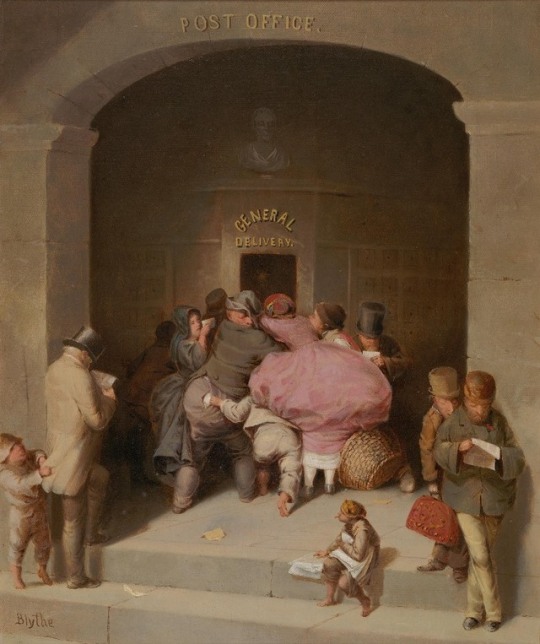#David Gilmour Blythe
Text

Lincoln Crushing the Dragon of Rebellion
David Gilmour Blythe
oil on canvas, 1862
#David Gilmour Blythe#art#artist#painter#painting#Lincoln Crushing the Dragon of Rebellion#oil on canvas#1862#what a trip#Boss Tweed#Tammany Hall
26 notes
·
View notes
Text

david gilmour blythe. a fisherman, date unknown.
1 note
·
View note
Text

'Art Versus Law'. David Gilmour Blythe. 1815-1865.
13 notes
·
View notes
Photo

Devil and Tom Walker by David Gilmour Blythe.
4 notes
·
View notes
Photo

Um ato prematuro
“...considero a abolição súbita e violenta do cargo de Master in Chancery, expressa na nova Constituição como um... ato prematuro; porquanto eu contara com proventos vitalícios, e final somente vim a auferir os de uns quantos anos.”
Herman Melville, “Bartlerby, o Escrivão”;David Gilmour Blythe, “O Sonho do Advogado”.
3 notes
·
View notes
Text

#anne with an e#anne shirley icons#livros#frases#cita??es de livros#citacoesdelivros#actors#illustration#travel#gilbert blythe#david gilmour#liz gillies#netflix#net neutrality#netherlands#network#love#loveit#my love#love quotes#self love
143 notes
·
View notes
Photo

Art versus Law, David Gilmour Blythe, 1859-1860, Brooklyn Museum: American Art
Size: frame: 32 7/8 × 29 × 2 5/8 in. (83.5 × 73.7 × 6.7 cm)
Medium: Oil on canvas
https://www.brooklynmuseum.org/opencollection/objects/622
6 notes
·
View notes
Photo

Corn Husking, David Gilmour Blythe, ca. 1863–64, American Paintings and Sculpture
Catharine Lorillard Wolfe Collection, Wolfe Fund, 1957
Size: 24 x 33 1/2 in. (61 x 85.1 cm)
Medium: Oil on canvas
https://www.metmuseum.org/art/collection/search/10191
6 notes
·
View notes
Text
today on "paintings i'd never seen until i googled something extremely specific for art purposes":

man putting on boots - david gilmour blythe, 1856-1860
9 notes
·
View notes
Photo

Old Virginia Home, David Gilmour Blythe, 1864, Art Institute of Chicago: American Art
Ada Turnbull Hertle Fund
Size: 52.7 × 73 cm (20 3/4 × 28 3/4 in.)
Medium: Oil on canvas
https://www.artic.edu/artworks/55380/
1 note
·
View note
Text

Horse Fair 1860
David Gilmour Blythe
Carnegie Museum of Art
24 notes
·
View notes
Link
Performing a Harold Pinter play is a delicate balance to borrow a phrase from the similarly difficult-to-mount Edward Albee. Pinter’s cryptic characters with their numerous pauses and minimalist dialogue can come across as icy or frustratingly inscrutable. Fortunately, the third Broadway revival of his Betrayal finds the sweet spot, imparting his meaningful insight on how people connect with and discard each other, unlike its two previous incarnations (I did not see the 1980 original NY production with Raul Julia, Roy Scheider, and Blythe Danner.) David Leaveaux’s 2000 staging for Roundabout with Liev Schreiber, John Slattery and Juliette Binoche was too nightmarish and menacing, missing the humor and passion. Mike Nichols went to the opposite extreme in his 2013 production headlined by Daniel Craig, Rachel Weisz, and Rafe Spall, emphasizing the laughs and delivering an almost sitcom-y evening. Jamie Lloyd combines the two qualities for a perfect blend of light and dark in his current bare-bones production, now on Broadway after a hit run in London. A trio of attractive British movie and TV stars with impressive stage credits—Tom Hiddleston, Charlie Cox and Zawe Ashton—deliver powerful performances, sexy and subtle in equal measure.
The play is an intricate puzzle box as well as a sharp-edged love triangle. That may be undoable in terms of geometry, but Pinter achieves this impossibility as well as crossing back and forth across time. If that sounds confusing, the playwright’s method will make sense upon viewing.
The plot charts the progress of an affair but in reverse chronological order so that casually-mentioned details take on explosive significance as we travel back in time. We first meet Emma and Jerry, bookish Londoners each married to other people and with two kids a piece, two years after their seven-year liaison has wound down. Jerry is best friends with Emma’s husband Robert, who also publishes several of the authors Jerry represents as an agent. At first, everything seems casual and civilized as the characters share drinks and lunch, but with every scene going further back into this three-way relationship—except for two vignettes which move forward—Pinter unflinchingly reveals how each has ruthlessly betrayed the other two.
Lloyd strips the play to its essentials and gets at the heart of Pinter’s portrait of easy deception and the pain it causes. Sutra Gilmour’s starkly elegant set, lit with painterly precision by Jon Clark, is a grey void on two concentric turntables. Ben and Max Ringham create a sound scape of disturbing dissonance and original pop-flavored songs played between scenes, evoking loss, anger, and hurt. All three principal cast members are present throughout the action and there is no intermission.
As noted, it would be easy for the participants to be played as too cool or too funny, but the superb cast makes these sly deceivers achingly sympathetic despite their transgressions. Hiddleston’s lean, handsome features eloquently play a symphony of Tom’s emotions which his clipped tones attempt to conceal. Ashton tellingly conveys Emma’s conflicted desires as she is pulled—sometimes literally—between two men. Cox plays Jerry as more open and vulnerable, giving equal weight to his selfish recklessness and to his pain and disappointment when both Emma and Robert turn on him. Eddie Arnold makes the most of a walk-on role of a convivial Italian waiter. All the players in this nasty three-sided game are out for themselves, but in this production, we can understand, but not necessarily sympathize with their actions—that’s not always true of a Harold Pinter production.
35 notes
·
View notes
Link
Izuka Hoyle and Julia McKenzie
How does it take more than three hours to present five awards? Have twelve finalists sing two songs each, which itself justifies an interval, and ask a judging panel to decide who wins what while the audience is treated to yet more musical theatre performances. But that only takes care of three awards, in the cumbersomely titled ‘Stephen Sondheim Society & Mercury Musical Developments Student Performer of the Year 2017 & Stiles + Drewe Prize’. This should really read ‘Stiles + Drewe Prizes’ (plural), as there are now two, one for composition, the other for potential, namely Best New Song and the Mentorship Award. These two awards are judged separately from the live competition.
I’m not entirely sure why, but this year’s offerings saw performances, for the most part, rather hammed up than might normally be expected from performances of Sondheim’s material, which has a tendency to be nuanced and melodic. The opening ensemble number set up what was to follow very well, an almost painfully slow rendering of ‘Putting It Together’ from Sunday in the Park with George, though done this way, it did allow for ‘every word, every line’ (to quote the song itself) to be clearly enunciated.
These are, one has to accept, students still, and the nerves can sometimes be quite telling. As ever with a competition of this nature, taking on a lesser known tune can work to a finalist’s advantage, though this cultured audience knew to suspend disbelief and not think of the various other productions and concerts in which they would have heard, for instance, ‘Losing My Mind’ from Follies.
It is to Verity Blyth’s performance of ‘Losing My Mind’ I turn to first. As host Clive Rowe pointed out, there were ‘technical things’ that happened, namely that someone else’s microphone was turned on, so that the entire Noel Coward Theatre momentarily heard one side of a conversation. The mark of a great performer, Rowe continued, is to carry on when something like that happens, as though it never did. It is indeed a hallmark of professionalism, and Blyth’s performance is itself worthy of mention in any case, being one of the few that didn’t attempt to act out every line. There was a poise and confidence even in a music break.
Of course, sometimes a role calls for an all-out performance. Joseph Wiltshire-Smith rose to the occasion in ‘Buddy’s Blues’, also from Follies, the only finalist to make full use of the stage space available. To quote a poster outside the theatre for Half A Sixpence, the current resident show at the Noel Coward, it sent “the audience into raptures”.
The new songs featured increased my confidence in new British musical theatre. It has, generally speaking, taken a different path from the glitz and glamour of the Broadway musical. Most of the offerings here are a stand and deliver approach, where it is not possible to say much about the choreography because there isn’t any choreography to say much about. But these ones are intriguing, drawing the audience into the narrative even as stand-alone songs. Georgia Frost’s performance of ‘Gerry and Me’ by Tom Lees and Claire Rivers was an example of a tune heavy on plot and full of pathos, as far away from the traditional song and dance as possible but nonetheless as worthy winner of the Stiles + Drewe Best New Song 2017.
[See image gallery at http://ift.tt/1FpwFUw]
Too much of a big deal was made about Tom Blackmore taking on a song originally written for a female character, in ‘What’ll It Be’ by Jim Barne and Kit Buchan. I would not have noticed if it hadn’t been pointed out repeatedly. I felt it was entirely irrelevant; it was a perfectly good performance of a perfectly good song (well done, Tom Blackmore!), and quite why it couldn’t be appreciated for what it was is something I can’t get my head around. Perhaps the panel is unaware of David Suchet playing Lady Bracknell, Glenda Jackson playing the title role in a production of King Lear, and numerous other gender-blind castings. Ironically, while they had left the auditorium to deliberate, one of the musical numbers the audience was treated to was ‘Broadway Baby’, sung by host Clive Rowe but – as you know, it was originally written for a female character. Again, so what? It was most enjoyable as it was.
I won’t attempt an analysis of all 24 songs sung by the twelve finalists (between them, that is). No meaningful explanation was given as to how the judging panel arrived at their decisions, and as all of the finalists were very good, I simply accept their decisions in good faith. Oscar Conlon-Morrey, taking the third prize of £250 kindly donated by panellist Julia McKenzie, sang ‘The Contest’ from Sweeney Todd, commanding the stage on his own in a number that has only one singing part but would ordinarily require a number of characters present on stage (it wouldn’t be much of a contest if Pirelli had no-one else to compete with). It was convincing, it took some guts, and his performance of a new song, ‘Work To Do’ by Ben Glasstone, demonstrated an ability to portray courage in that second number as effortlessly as flamboyancy in the first.
I personally thought Shaq Taylor, winner of the second prize (£500, donated jointly by David Langrish and the Sarah Thorne Theatre in Broadstairs, and the Newsome family), could have been a tad more sinister as the title character in Sweeney Todd has his ‘Epiphany’. His performance of ‘Apology to a Child’ by Tom Slade, was utterly sublime, a simultaneously smooth and soaring number.
Izuka Hoyle, winning the Student Performer first prize of £1,000 (kindly donated by Tricia Sharpe and Ray Barker) did a worthy and well-controlled rendering of ‘Last Midnight’ from Into The Woods. The new song she performed, ‘The Matchmaker’ by Claire McKenzie and Scott Gilmour, quickly established a rapport with musical director Stephen Ridley, and then with the audience (and therefore with the judges) that lasted right to the end of the number, exhibiting a beautiful vocal belt without overdoing it, just the right balance.
At the interval, somebody remarked to me that they had hoped for more softer numbers in the second half, as we had quite a few full-throated performances in the first. My fellow theatregoer did not have his wish granted, but, on balance, it is better to hear and see clearly what is being sung and performed than having to strain our ears and eyes. Such was the positivity at this encouraging event, it became difficult to ascertain who was uplifting whom: the performers were thrilled by a heartened panel and a supportive audience, while the panel and audience where inspired by the performers. That’s just how an event like this should be.
By Chris Omaweng
Student Performer of the Year 2017: Izuka Hoyle
Second prize: Shaq Taylor
Third prize: Oscar Conlon-Morrey
Stiles + Drewe Best New Song 2017: ‘Gerry and Me’ by Tom Lees and Claire Rivers
Stiles + Drewe Mentorship Award 2017: Reanimator by Ben Glasstone
The Stephen Sondheim Society and Mercury Musical Developments annual West End Gala for
The Stephen Sondheim Society Student Performer of the Year and The Stiles + Drewe Prize
Hosted by Clive Rowe
Director: Chris Hocking
Musical director: Stephen Sondheim
11th June 2017 3pm
At Noёl Coward Theatre
St Martin’s Lane, London, WC2N 4AU
The 12 finalists from performing arts schools around the country were selected to perform at the 2017 competition. The gala included a special performance by Olivier Award winner and guest judge Janie Dee – soon to be seen as Phyllis in Follies at the National Theatre and writer and broadcaster Edward Seckerson Chaired the Student Performer judges together with legendary Sondheim interpreter Julia McKenzie to present the prize.
Judges: Rachel Kavanaugh (Half a Sixpence and The Wind in the Willows), Simon Lee (The Sound of Music, Tell Me On A Sunday), Alex Young (SSSSPOTY 2010 winner, Carousel at ENO), Dan Gillespie Sells (The Feeling, Everyone’s Talking About Jamie) and Giles Terera (soon to star as Aaron Burr in Hamilton).
http://ift.tt/2sesoEv LondonTheatre1.com
0 notes
Photo

Corn Husking by David Gilmour Blythe via American Paintings and Sculpture
Medium: Oil on canvas
Catharine Lorillard Wolfe Collection, Wolfe Fund, 1957 Metropolitan Museum of Art, New York, NY
http://www.metmuseum.org/art/collection/search/10191
0 notes
